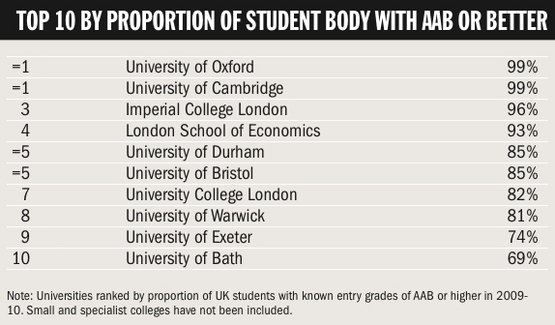The traditional view of a higher education sector divided along mission group lines may have been "shattered" by the release of data showing where top-achieving students study, it has been suggested.
The table, published by the Higher Education Funding Council for England last week, shows large differences among the research-intensive groups, with some institutions having lower proportions of top-grade students than more teaching-led institutions.
At the University of Essex, for example, which is a member of the 1994 Group, just 8 per cent of UK students with known entry grades had at least AAB at A level or its equivalent - the same proportion as the universities of Worcester, Lincoln and Teesside.
Some Russell Group universities have also generated "surprising" results.
The University of Liverpool (32 per cent) was one of five members where fewer than half of students had AAB grades or better.
One vice-chancellor, who did not want to be named, said the proportions - which relate to data on student numbers collected in 2009-10 - would "blow apart" conceptions of the markets different universities operate in.
He added that they could also have serious consequences owing to the government's White Paper proposals to allow competition for 65,000 AAB students and its intention to put a further 20,000 places up for grabs for institutions charging the lowest tuition fees.
As part of the plans to create the 20,000-place "margin", the government intends to cut all institutions' student numbers by 8 per cent after their AAB numbers have been removed, using data from this year.
Universities with a lower proportion of AAB students will have a larger "core" left exposed to this process.
If this year's figures match those recorded for 2009-10, Liverpool would lose more than 150 student places to create the margin, whereas the University of Bristol - where 85 per cent of students with known grades had AAB or better - would have its core cut by just over 30.
To make up these numbers, universities would either have to recruit more AAB students or charge fees of less than £7,500 to bid for the marginal places - an unlikely move for 1994 and Russell Group institutions.
Either up or down
Chris Snowden, vice-chancellor of the University of Surrey, said his institution had "no choice" but to move further towards AAB "territory" to make up the numbers - to the possible detriment of students with other grades and qualifications.
"Our target area is AAB and higher, but we have been willing to look at people with equivalent levels of qualifications outside the Hefce-defined AAB. (The White Paper proposals) mean we won't be able to ... I think that's a pity," he said.
He added that Surrey - which now has a proportion of AAB students "significantly" higher than the 23 per cent recorded in the 2009-10 table - had no plans to lower fees.
But he speculated that those institutions that recruit a lot of students with grades just below AAB may have to contemplate such a move or recruit more overseas students.
Libby Hackett, director of the University Alliance, said problems will start to arise from running the AAB and price-margin systems "side by side" if the government rolls it forward over a number of years.
"You quickly reach an unsustainable position where you can't operate in that market between £7,500 and £9,000," she said.
Ms Hackett added that choice for the students taking up the 20,000 marginal places was being "severely constrained" to a small number of institutions and new providers charging £7,500 or less.
Bahram Bekhradnia, director of the Higher Education Policy Institute, said it also remained to be seen whether demand from students would be high enough for further education colleges and other providers to scoop up the marginal places.
"In the past there have been further education colleges with unfilled places and this might become more prevalent in the future," he said.
But Clive Behagg, vice-chancellor of the University of Chichester, which will charge just under £7,500 in 2012-13 and had a 13 per cent AAB count in 2009-10, said the system provided a good "opportunity" for small "perfectly formed" institutions such as his.

• Full AAB data by university is available at bit.ly/qAKEn2
Register to continue
Why register?
- Registration is free and only takes a moment
- Once registered, you can read 3 articles a month
- Sign up for our newsletter
Subscribe
Or subscribe for unlimited access to:
- Unlimited access to news, views, insights & reviews
- Digital editions
- Digital access to THE’s university and college rankings analysis
Already registered or a current subscriber?
